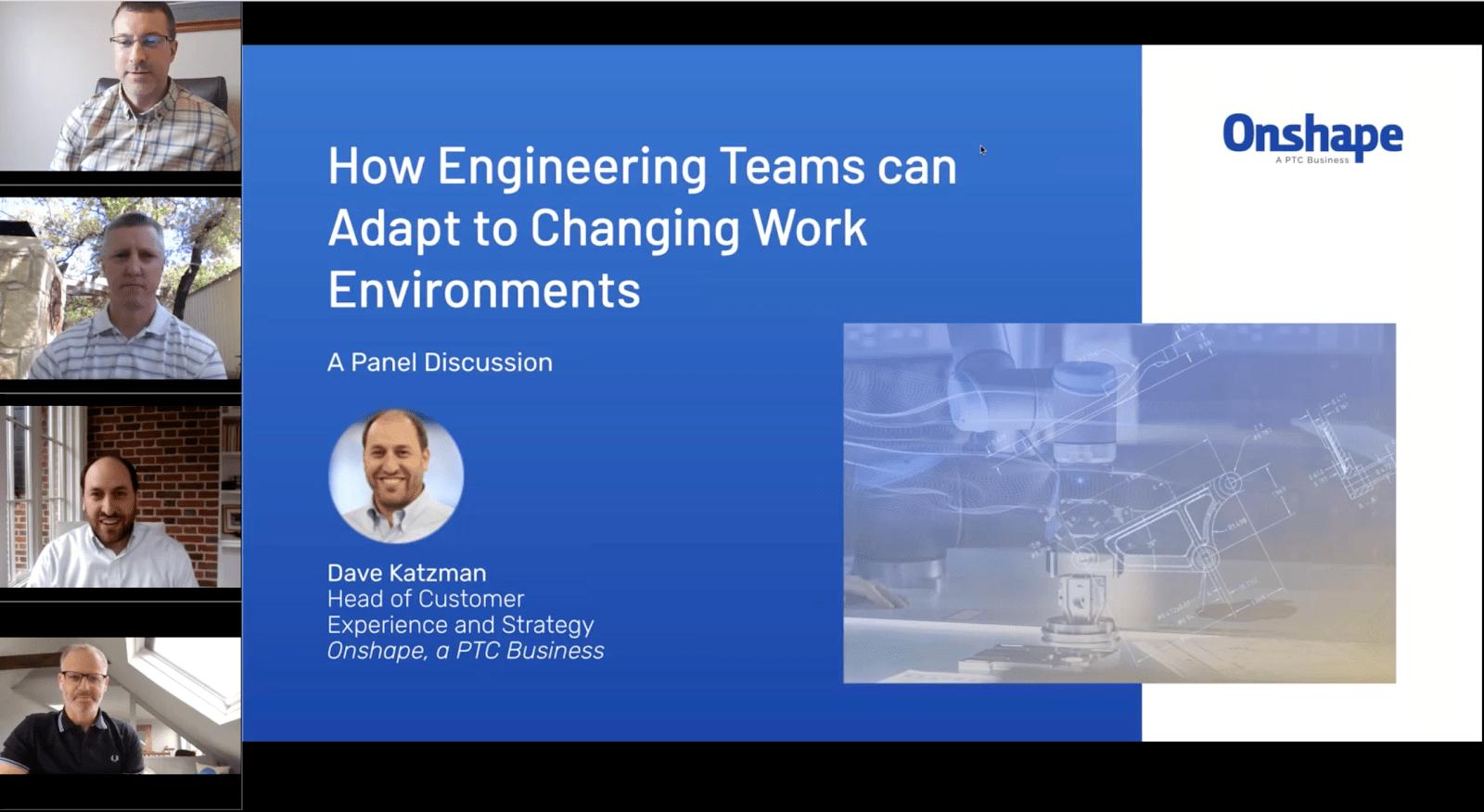
07:25
Depending on where you live in the world, it is likely that your company has been forced to temporarily transition to a remote workforce due to the circumstances of the COVID-19 pandemic. Different industries have been hit harder than others. As Sean Grundy, the CEO of Bevi, recently told The Boston Globe, “Our risk models never included the possibility that literally the whole world would stop going to work one day — that is a pretty out-there scenario.”
Although current events have shocked us all into rethinking about how we do our jobs – or in some cases if we can do them at all – much of the business world had already been experiencing a shift toward a more flexible work environment well before the crisis.
To get a snapshot of how companies from various industries are adapting to, in some cases, a 100-percent remote workforce, PTC’s David Katzman , VP of Customer Experience and Strategy for Onshape, reached out to some of our partners and customers to ask how they were doing.
Katzman remotely hosted a panel discussion on “How Engineering Teams Can Adapt to Changing Work Environments.” If you missed the discussion, I’d like to share some highlights.
Lessons From Working Remotely

From the top left of the video screen, joining Dave in the conversation were:
- Chad Manuell – Global Director of Engineering for Trek Bicycle, manufacturer of the Trek, Bontrager, Electra, BCycle, Mansion Hill and DreamBikes brands.
- Will Tiller – Engineering Lead for Dixie Iron Works, manufacturer of valves, fittings and well service pumps for the oil and gas industry; and
- Barry Kelly – CEO of Thought Industries, a leading software company specializing in online enterprise learning technology.
Here are 13 key takeaways from the conversation:
1. Yes, Some Manufacturing Work Can Be Done From Home
“If an employee is working from home, clearly they can't run a CNC machine. But they can work on developing processes related to the parts they run on their machine,” says Tiller (Dixie Iron Works). “You can focus on important, but not urgent, work. Things like quality assurance. Look at things that happen in your daily work activities that could be better, could be improved, that you have problems with – and spend this time just working on those processes. Try to fix the things that you normally don't have time to fix.”
2. It’s Time to Rethink Your Supply Chain
“We’ve definitely given a lot of thought to our supply chain over the last year and especially more recently,” says Manuell (Trek). “We've started working toward having two options for every part, so that if one area of the world can't work, we've got another factory in another area that can. This takes a while to implement and adds an additional load to the engineering and development teams to bring products up in two different factories. But in my opinion, it's definitely worth the investment.”
3. Add More Voices Earlier in Your Design Reviews
“I think you'll find that as you get more comfortable with having remote design reviews with your team, that you’ll realize you can take the same approach to involve your suppliers and customers,” says Tiller (Dixie Iron Works). “That is something that we've used to really get more input at the beginning of a design phase from both ends of the chain, and we believe it helps us come up with a better product in the end.”
4. Embrace Cloud Productivity Tools
“We're cloud based with the way we organize using Microsoft Workfront, so anyone around the globe can log in and know what their tasks are for the day,” says Manuell (Trek). “And our work with Onshape and other cloud tools help us as we look toward the future to try to be less tied to a desk. It's especially interesting as we've started to onboard people during this new transition. We've brought on three new engineers in the past week. And, boy, you're trying to get everyone set up remotely, computers shipped to them, software installed. It's crazy.”
5. Remote Teams Can Add a More Global Perspective to Product Development
“We definitely think globally, but at the same time if you're working at headquarters, you're surrounded by the same people every day. I think being remote has added to our global perspective,” says Manuell (Trek). “Everyone has a different perspective on the marketplace given where they live, so when you get people to chime in from Holland or Germany or Taiwan on a bicycle that's being designed in Waterloo, Wisconsin, you add depth to the product that you wouldn't have if you didn't have dispersed teams. Even just across the United States, west coast to east coast, people use bikes differently. So, the more perspectives we can bring together, and the more iterations we can do based on those perspectives, the better product we’ll deliver to our consumer.”
6. It’s Better to Over-Communicate
“Our sales team is used to having daily stand-up meetings in the office every morning, and there’s been no problems doing those virtually. Be willing to over-communicate,” says Kelly (Thought Industries). “Some of the best remote workers are those who always feel really present and are willing to try a little bit harder, work a little bit harder, to remain in front of people and communicate.”
7. Get Up and Move
“After the first week of being at home, my back was killing me from having to stare into a camera for eight straight hours,” says Kelly (Thought Industries). “This week, I had my one-on-ones with the executive team. And I said, ‘We're all walking. Bring anything that you have on your phone. We're going to have a walking meeting.’ Because I couldn't imagine another day of staring into a camera!”
8. Re-evaluate Your Time Management
“I actually think things are moving faster now,” says Manuell (Trek). “People don't wait to drop by in person or wait for a meeting. They're hitting someone with a quick question on Teams or they're sending a text or making a phone call and getting answers really quickly. It seems like people just are really going with the flow and using tools in a different way than they've ever used them before to be more productive.”
9. Embrace Empathy for Your Co-Workers and Customers
"I think if I were doing a webinar six weeks ago and my kids ran into the frame, I’d have less patience with it,” says Kelly (Thought Industries). “But people understand we're all human, we're all trying to get a job done. This is a great time for reflection, for creativity. I think I read something the other day about how we're going to see some incredible innovations and products coming because people have more time to think. We're very grateful to our customers. Everyone is really coming together and has great empathy for each other.”
10. You Can Still Measure Productivity at Home
“Most leaders have some metrics for a certain task and how long it should take,” says Tiller (Dixie Iron Works). “How long was that task taking in the traditional office setting where a junior engineer is going to the coffee machine every hour and a half, or somebody stops in their office to interrupt them about some unrelated topic? It comes down to the person. Some people do not readily adapt to the home-work environment. It takes a lot of discipline, but certainly you can measure for an equivalent task what time it takes in either of these two modes of working.”
11. Try to Keep Being Social
“We use a little product called ‘Donut’ inside Slack that randomly connects you with someone else in the organization that you might not interact with every day,” says Kelly (Thought Industries). “And that's an opportunity for you to go and spend a 15 minute or half-hour coffee break or have a lunch meeting. It's just a good way for all of us to connect with individuals that we ordinarily wouldn’t see on a day-to-day basis.”
12. Set Boundaries Between Work and Home Life
"Be careful about the line between home and work because it can go both ways,” says Kelly (Thought Industries). “On one hand, I feel like work can always be there at 8, 9, and 10 o'clock at night. But Netflix can also be there at 1 o'clock in the afternoon. So you have to set some standards for yourself and just stick with them. It’s something you have to keep working on.”
13. Employees Appreciate Transparent Leadership
“Our CEO John Burke’s guidance through this time has been amazing,” says Manuell (Trek). “He has upped the frequency of his updates for our company. He does weekly videos to the entire company telling everyone exactly what's going on and how we're going to react to it. I think it's been a model for all of us to make sure we're doing the daily updates that we do and make sure we're all being really transparent.”
As Will Tiller from Dixie Iron Works puts it, “If there were any companies on the fence about how remote working could work out, these past few weeks have definitely pulled the band-aid off.”
If you’d like to listen to the rest of the remote workplace discussion, click on the link below.
Latest Content

- Case Study
- Automotive & Transportation
Zero Crashes, Limitless Collaboration, One Connected Workflow With Cloud-Native Onshape
12.04.2025 learn more
- Blog
- Aviation, Aerospace & Defense
- Branching & Merging
- Custom Features
- Learning Center
- Onshape Government
Why Aerospace & Defense Teams Choose Onshape for Product Development
12.18.2025 learn more
- Blog
- Evaluating Onshape
Cloud-Native CAD 2025 Wins: Revenue Growth, Real-Time Collaboration, Unified CAD-CAM
12.17.2025 learn more
- Blog
- Becoming an Expert
- Assemblies
- Simulation
Mastering Kinematics: A Deeper Dive into Onshape Assemblies, Mates, and Simulation
12.11.2025 learn more



